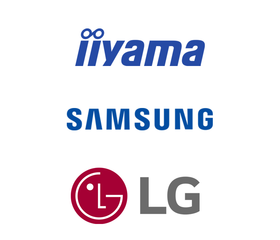Commercial-grade displays and TVs might look similar, but they are designed for very different purposes and environments. Many customers believe that consumer-grade TVs are durable enough for commercial areas; however, this is not recommended due to differences in screen durability and brightness.
Here are the main differences between them:
-
Durability and Operational Capacity:
- Commercial-grade displays are built to operate for longer hours, often up to 24/7 without turning off, and are constructed with more durable components to withstand continuous use. They also typically have better heat dissipation systems to manage the stress of long hours.
- Consumer TVs are generally intended for less frequent use, typically a few hours per day, and may not hold up as well under continuous operation.
-
Brightness and Image Quality:
- Commercial-grade displays usually offer higher brightness levels to remain visible in brightly lit environments, such as outdoors or in retail settings. They also often have anti-glare surfaces.
- Consumer TVs are designed primarily for home use, where lighting conditions are more controlled, so they might not perform as well under bright ambient lighting.
-
Connectivity and Control:
- Commercial-grade displays often include more robust connectivity options for integrating into various systems and networks. They may include features like RS-232C for remote control, which allows for integration with a broader range of devices and systems.
- Consumer TVs typically have standard HDMI, USB, and sometimes Ethernet connections, focused more on home entertainment systems.
-
Warranty and Support:
- Commercial-grade displays come with warranties that support long hours of operation and may offer quicker service or replacements to avoid downtime in a business setting.
- Consumer TVs usually have warranties that might not cover issues arising from being used in a commercial setting, like overheating from being on 24/7.
-
Cost:
- Commercial-grade displays are more expensive due to their enhanced durability, advanced features, and ability to operate in demanding environments.
- Consumer TVs are less costly but are designed for less rigorous use.
A few questions and answers between Commercial Grade Displays and Smart Consumer TVs.
Can I have use Consumer TVs in commercial areas?
Consumer TVs can be used as commercial digital signage, but they have limitations compared to professional digital signage displays and the brightness level, capacity is might be weak comparing commercial grade displays. Consumer TVs are designed primarily for home use and may not be built to handle the extended operational hours and continuous use that commercial environments typically require. Additionally, professional digital signage displays often have features like higher brightness levels for better visibility in various lighting conditions, more durable components, built-in networking capabilities, and the ability to operate in portrait mode, which consumer TVs usually lack.
What are the key differences between consumer TVs and commercial digital signage displays?
Consumer TVs are designed for home use with limited operational hours, typically having lower brightness and less durable components. Commercial digital signage displays, on the other hand, are built to withstand continuous operation, often 24/7, with higher brightness levels, more robust components, and features like portrait mode operation and advanced networking options.
Can consumer TVs be used outdoors for digital signage?
Consumer TVs are generally not suitable for outdoor use because they lack the necessary brightness to be visible in direct sunlight and are not built to withstand weather conditions. Outdoor digital signage typically requires specially designed displays with weatherproofing and enhanced brightness.
Is it cost-effective to use consumer TVs for business purposes?
Initially, using consumer TVs may seem cost-effective due to their lower price point. However, in the long run, the higher failure rates and shorter lifespans due to non-stop usage can result in more frequent replacements and higher total costs compared to investing in commercial-grade displays designed for prolonged use.
In this way you may need to pay double by purchasing second screen or deciding to move forward to commercial displays.
If you are looking for a commercial display for your business, feel free to contact us at 0208 1919 223 or email us at info@screenmoove.com.
Our expert team will help you find the right screen and solution for your needs.





